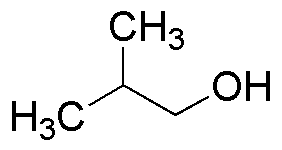Isobutyl alcohol is widely utilized in research focused on various practical applications across multiple industries:
- Solvent in Chemical Reactions: It serves as an effective solvent for organic compounds, making it essential in laboratories for synthesizing chemicals and conducting reactions.
- Intermediate in Chemical Manufacturing: Used as a building block in producing various chemicals, including esters and plasticizers, which are crucial in the production of plastics and coatings.
- Fuel Additive: Its properties allow it to enhance the performance of fuels, improving combustion efficiency and reducing emissions in automotive applications.
- Personal Care Products: Commonly found in cosmetics and personal care formulations, it acts as a solvent and helps in the stabilization of products like lotions and creams.
- Pharmaceutical Applications: Utilized in the formulation of certain medications, it aids in the solubility and delivery of active ingredients, enhancing therapeutic effectiveness.
General Information
Properties
Safety and Regulations
Applications
Isobutyl alcohol is widely utilized in research focused on various practical applications across multiple industries:
- Solvent in Chemical Reactions: It serves as an effective solvent for organic compounds, making it essential in laboratories for synthesizing chemicals and conducting reactions.
- Intermediate in Chemical Manufacturing: Used as a building block in producing various chemicals, including esters and plasticizers, which are crucial in the production of plastics and coatings.
- Fuel Additive: Its properties allow it to enhance the performance of fuels, improving combustion efficiency and reducing emissions in automotive applications.
- Personal Care Products: Commonly found in cosmetics and personal care formulations, it acts as a solvent and helps in the stabilization of products like lotions and creams.
- Pharmaceutical Applications: Utilized in the formulation of certain medications, it aids in the solubility and delivery of active ingredients, enhancing therapeutic effectiveness.
Documents
Safety Data Sheets (SDS)
The SDS provides comprehensive safety information on handling, storage, and disposal of the product.
Product Specification (PS)
The PS provides a comprehensive breakdown of the product’s properties, including chemical composition, physical state, purity, and storage requirements. It also details acceptable quality ranges and the product's intended applications.
Certificates of Analysis (COA)
Search for Certificates of Analysis (COA) by entering the products Lot Number. Lot and Batch Numbers can be found on a product’s label following the words ‘Lot’ or ‘Batch’.
*Catalog Number
*Lot Number
Certificates Of Origin (COO)
This COO confirms the country where the product was manufactured, and also details the materials and components used in it and whether it is derived from natural, synthetic, or other specific sources. This certificate may be required for customs, trade, and regulatory compliance.
*Catalog Number
*Lot Number
Safety Data Sheets (SDS)
The SDS provides comprehensive safety information on handling, storage, and disposal of the product.
DownloadProduct Specification (PS)
The PS provides a comprehensive breakdown of the product’s properties, including chemical composition, physical state, purity, and storage requirements. It also details acceptable quality ranges and the product's intended applications.
DownloadCertificates of Analysis (COA)
Search for Certificates of Analysis (COA) by entering the products Lot Number. Lot and Batch Numbers can be found on a product’s label following the words ‘Lot’ or ‘Batch’.
*Catalog Number
*Lot Number
Certificates Of Origin (COO)
This COO confirms the country where the product was manufactured, and also details the materials and components used in it and whether it is derived from natural, synthetic, or other specific sources. This certificate may be required for customs, trade, and regulatory compliance.


